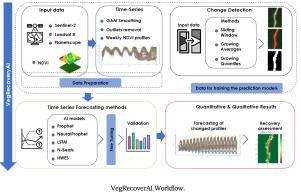VegRecoverAI: A deep learning-based system for automated vegetation recovery assessment and prediction with demonstration case study on gas pipeline construction
IF 4.6
2区 环境科学与生态学
Q1 COMPUTER SCIENCE, INTERDISCIPLINARY APPLICATIONS
引用次数: 0
Abstract
Vegetation restoration is crucial for environmental conservation and maintaining ecosystem services. Traditional methods, such as manual inspections and expert photo interpretation, have been widely used to assess vegetation recovery but are labor-intensive, time-consuming, and prone to human bias. In contrast, modern Artificial Intelligence (AI) based methods use satellite imagery for efficient vegetation analysis, enabling large-scale monitoring with minimal human effort. This paper introduces VegRecoverAI, a comprehensive system that leverages multisource satellite data from Landsat, Sentinel-2, and PlanetScope. VegRecoverAI autonomously detects both subtle and significant vegetation changes, providing a reliable alternative to manual assessment. The system extracts NDVI time series data, detects vegetation change and uses an ensemble of forecasting models to predict future vegetation restoration. The system is demonstrated as a case study following gas pipeline construction in Italy. The results indicate that VegRecoverAI is automated and a scalable solution complementary to traditional techniques to support proactive environmental management.

VegRecoverAI:基于深度学习的自动植被恢复评估和预测系统,并以天然气管道建设为例进行了示范研究
植被恢复对环境保护和维持生态系统服务至关重要。传统的方法,如人工检查和专家照片解释,已广泛用于评估植被恢复,但这是劳动密集型的,耗时的,并且容易受到人为偏见。相比之下,现代基于人工智能(AI)的方法使用卫星图像进行有效的植被分析,从而以最少的人力进行大规模监测。VegRecoverAI是一种综合利用Landsat、Sentinel-2和PlanetScope多源卫星数据的综合系统。VegRecoverAI自动检测细微和显著的植被变化,为人工评估提供可靠的替代方案。该系统提取NDVI时间序列数据,检测植被变化,并使用集合预测模型预测未来植被恢复。该系统以意大利天然气管道建设为例进行了验证。结果表明,VegRecoverAI是一种自动化的、可扩展的解决方案,是传统技术的补充,可支持主动环境管理。
本文章由计算机程序翻译,如有差异,请以英文原文为准。
求助全文
约1分钟内获得全文
求助全文
来源期刊

Environmental Modelling & Software
工程技术-工程:环境
CiteScore
9.30
自引率
8.20%
发文量
241
审稿时长
60 days
期刊介绍:
Environmental Modelling & Software publishes contributions, in the form of research articles, reviews and short communications, on recent advances in environmental modelling and/or software. The aim is to improve our capacity to represent, understand, predict or manage the behaviour of environmental systems at all practical scales, and to communicate those improvements to a wide scientific and professional audience.
 求助内容:
求助内容: 应助结果提醒方式:
应助结果提醒方式:


